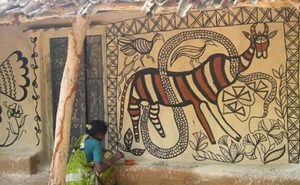2nd edition of Kala Utsav 2025:

Artists from Jharkhand, Odisha, and West Bengal participated in the 2nd edition of Kala Utsav 2025 – ‘Artists in Residence Programme’ at Rashtrapati Bhavan, showcasing traditional paintings like Sohrai Khovar, Pattachitra, and Patua.
- The program honors India’s living art traditions while offering a platform for folk, tribal, and traditional artists to showcase their work
Sohrai Painting:
- It is a traditional indigenous art form practiced by women from various tribal communities in the Hazaribagh region of Jharkhand, including the Kurmi, Santhal, Munda, Oraon, Agaria, and Ghatwal groups. Known as harvest art, it is deeply linked to agriculture and cattle domestication. The term ‘Soh’ or ‘Soro’ means to drive away, and ‘Rai’ refers to a stick. As part of the ritual, mandalas or aripan are drawn with rice gruel to welcome cattle into homes, a task performed by village women using their fingers. Sohrai Khovar Painting has received the Geographical Indication (GI) tag in the year 2020.
Patta Chitra:
- Originating in Odisha, it is closely associated with the Jagannath Temple in Puri, where it is traditionally used to decorate the sanctum sanctorum.
- Pattachitra, painted on cloth (Pata) coated with chalk powder and tamarind seed glue, uses natural colors from vegetable, earth, and mineral sources.
- Themes include religious, mythological, and folk stories, notably Krishna Leela and Lord Jagannath.
- Without pencils or charcoal, artists start with borders and sketch directly with light red and yellow brushes, finishing with a lacquer coating for shine and water resistance.
Patua Painting:
- It is a folk art tradition from West Bengal, practiced by the Patua or Chitrakar community (both Hindu and Muslim).
- Patua artisan community is also found in Bihar, Jharkhand, Odisha, and parts of Bangladesh.
- It is painted on cloth scrolls called pati or patta, backed with old sari fabric, using bamboo-goat hair brushes and vegetable dyes fixed with gum.
- It is used to narrate Mangal Katha, especially by Hindu Patuas in Kalighat and Kumartuli.




